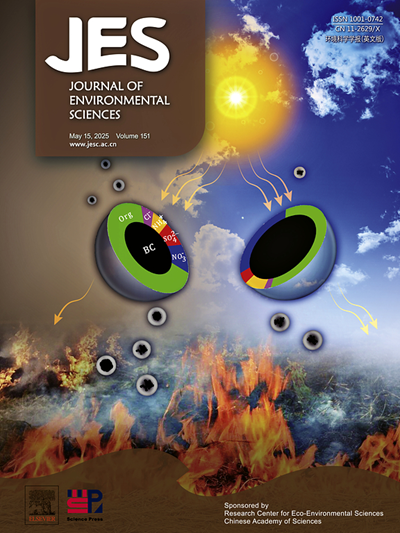Pig bedding biochar enhances the Cd extraction capacity of Perilla frutescens by mitigating the toxicity of Cd-contaminated soil
IF 5.9
2区 环境科学与生态学
Q1 ENVIRONMENTAL SCIENCES
引用次数: 0
Abstract
Pig bedding biochar (PBBC) and Cd-enriched Perilla frutescens were used for joint remediation of Cd-contaminated soil. Cd-contaminated soil was treated with different concentration of PBBC. The physiological and biochemical indicators of P. frutescens was evaluated under different Cd stress, including biomass, antioxidant system. Meanwhile Cd bioavailability, enzyme activity and nutrient bioavailability of the soil were monitored. Results revealed that PBBC at 1 % and 5 % levels led to decreased diethylenetriaminepentaacetic acid-extractable Cd (DTPA-Cd) content in soil by 19.09 %-20.05 % and 30.10 %-47.08 %, respectively. Moreover, PBBC promoted the transformation of exchangeable Cd (EXC-Cd) into a more stable form, enhanced soil enzymes (peroxidase, acid phosphatase, urease, and sucrase) activities, and alleviated P. frutescens 's oxidative stress. PBBC increased its biomass, consequently enhancing Cd accumulation in the plant's, thereby improving Phytoextraction rate (PER). 1 % PBBC showed the best effect, with a total biomass increased 21.42 %-26.94 %, PER was enhanced by 39.83 %-54.82 %. This study justifies that the combining PBBC with P. frutescens enhances Cd removal from soil, making the PBBC-P. frutescens a promising choice for treating Cd-polluted soil.

猪垫料生物炭通过减轻Cd污染土壤的毒性,提高紫苏对Cd的提取能力
采用猪垫料生物炭(PBBC)和富含cd的紫苏联合修复cd污染土壤。用不同浓度的PBBC处理镉污染土壤。在不同镉胁迫下,测定了金银花的生物量、抗氧化系统等生理生化指标。同时监测土壤Cd生物有效性、酶活性和养分生物有效性。结果表明,1%和5% PBBC处理可使土壤中二乙烯三胺五乙酸可萃取Cd (DTPA-Cd)含量分别降低19.09% ~ 20.05%和30.10% ~ 47.08%。此外,PBBC还促进了可交换性Cd (ex -Cd)向更稳定形态的转化,提高了土壤酶(过氧化物酶、酸性磷酸酶、脲酶和蔗糖酶)活性,减轻了果蔓的氧化应激。PBBC增加了其生物量,从而增加了Cd在植物体内的积累,从而提高了植物提取速率(PER)。添加1% PBBC效果最好,总生物量提高21.42% ~ 26.94%,PER提高39.83% ~ 54.82%。本研究证明,PBBC- p与果苔草配用可提高土壤中Cd的去除效果,使PBBC- p具有良好的土壤活性。果蔓是处理镉污染土壤的一种很有前途的选择。
本文章由计算机程序翻译,如有差异,请以英文原文为准。
求助全文
约1分钟内获得全文
求助全文
来源期刊

Journal of Environmental Sciences-china
环境科学-环境科学
CiteScore
13.70
自引率
0.00%
发文量
6354
审稿时长
2.6 months
期刊介绍:
The Journal of Environmental Sciences is an international journal started in 1989. The journal is devoted to publish original, peer-reviewed research papers on main aspects of environmental sciences, such as environmental chemistry, environmental biology, ecology, geosciences and environmental physics. Appropriate subjects include basic and applied research on atmospheric, terrestrial and aquatic environments, pollution control and abatement technology, conservation of natural resources, environmental health and toxicology. Announcements of international environmental science meetings and other recent information are also included.
 求助内容:
求助内容: 应助结果提醒方式:
应助结果提醒方式:


